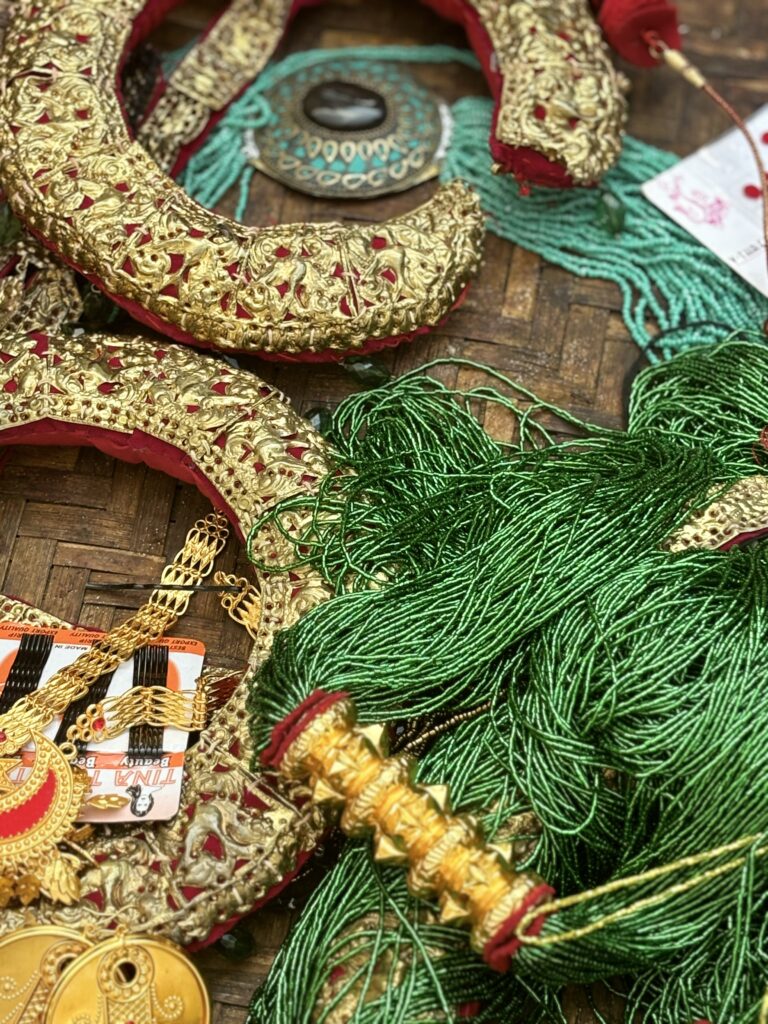It was one of those Shillong mornings where the clouds threatened to dampen the spirit of the day. The sky, heavy with rain, felt like it might turn the city into a puddle. But by 11 am, as if nature itself was in sync with the cultural pulse of the community, the skies cleared, and the sun burst through—a perfect metaphor for what was to come.
On April 13, 2025, the Akhil Shillong Nepali Mahila Samity (ASNMS) organized the first-ever Gorkha Haat Baisakh Celebration at the Gorkha Pathshala Higher Secondary Assembly Ground, Shillong. It wasn’t just an event. It was a heartfelt, grassroots celebration of Nepali New Year—Poila Baisakh 2082—infused with culture, community, womanhood, and cross-cultural unity.
of Memories and Meanings
The “Haat”—or traditional market—was a living museum of Gorkha heritage. There were stalls brimming with indigenous Nepali foods: hot, crispy Sel Roti, the spicy depth of Teel ko chutney, the rare and flavourful Gundruk ko achaar, jars of sinki, bhatt, and the earthy richness of kodo ko pitho. There was even a vibrant mini-Newari thali, a dish that seemed to narrate centuries of Newar tradition in just a bite.
Each stall was lovingly put up by members of the Mahila Samity and SHG groups from different parts of Shillong. More than just a showcase of culinary traditions, it was an affirmation of community resilience, creativity, and collective memory.
But the haat was not only about food.
It was also about stories told through dance and song—16 vibrant cultural performances graced the stage, from the enthralling Rai Sakela dance by guest artists from Umlapher, to the graceful Maruni and Magar dances, the powerful Khukuri dance, folk songs, and original poetry. It was a full-bodied expression of Gorkha identity.
Presiding over the event as Chief Guest, Shri Chandramani Adhikari addressed the gathering with warmth and vision. He reminded everyone of the deeper essence of the celebration:
“We often celebrate New Year on January 1st, but for us, this is the real new year—Baisakh 1, 2082 according to the Nepali calendar. It is the beginning of new hopes, new starts. In other parts of India too—Uttar Pradesh, Bihar, Uttarakhand, Rajasthan—this day is celebrated under different names. Even in Assam, it’s Bihu. In South India, too, it’s celebrated. Nepal and Bhutan mark this day grandly. And today, in Shillong, we see this richness unfold.”
He went on to praise the effort of the Mahila Samity:
“It is beautiful how you’ve managed to display not only our food but the very items we use every day—utensils, clothes, musical instruments. This is more than celebration—it’s education, a gentle reminder of our roots.”
The Women Behind the scene
At the heart of this celebration was the quiet power of women. Speaking to the founder of indiangorkha.com, Ms. Sumitra Pradhan, President of ASNMS, reflected on the purpose of the Gorkha Haat:
“This is the first time we’ve organized this kind of event, and we did it in just ten days. Yes, it’s small, but it’s a start. We wanted our Gorkha youth to see our culture, understand our traditions, and learn about the things we use—our utensils, musical instruments, even our clothes. So they can carry it forward.”
But it was also, very deeply, about the women.
“Our women—our homemakers—spend their lives inside four walls, cooking, stitching, caring for families. They are talented, capable, and creative. Events like these give them a platform to come out, showcase their skills, and interact. It’s about building confidence, encouraging peer support, and helping them know about government schemes and opportunities,” she said.
Ms. Pradhan also shared a bit of the organization’s inspiring legacy:
“Our Samity was established in 1964 and registered in 1966. It’s one of the oldest organizations from the days of undivided Assam. It was actually a man, Late Subedar Durga Bahadur Thapa, who encouraged the women of our community to form this group. We’ve been working ever since—offering support during sickness, giving vocational training in tailoring and embroidery, and even starting adult education classes.”
A moving moment during the event was the warm presence and support from the Khasi community. The Dorbar Shnong of Nongsohphoh Upper Mawprem, represented by Mr. Hardy Ryntathiang, praised the initiative:
“Just like our own Khasi traditions of weekly haats—like Iewduh or Mawlonghat—this event reminded us how deeply markets are tied to culture, identity, and community. It’s wonderful to see people from different backgrounds come together, share food, music, and joy.”
“This celebration proves that we may come from different roots, but we are all neighbours and friends, and members of the same society. Let’s continue to strengthen our bonds—and with that, also fight anti-social activities with respect, unity, and togetherness.”
A standout among the stalls was the Gorkha Boutique, which caught everyone’s eye with its vibrant display of traditional dresses and accessories, merging pride in heritage with aesthetic elegance.
As the sun set behind the hills and the last notes of a folk song faded into the cool Shillong air, there was a sense of something profound—something that had been awakened. In a world often too fast to forget, this small, rain-washed event reminded everyone present that remembering is, in itself, an act of revolution. And that culture, when carried by the hearts of women and supported by the hands of a community, never truly disappears.
Want to write for us? Reach out to us at indiakogorkha@gmail.com!

